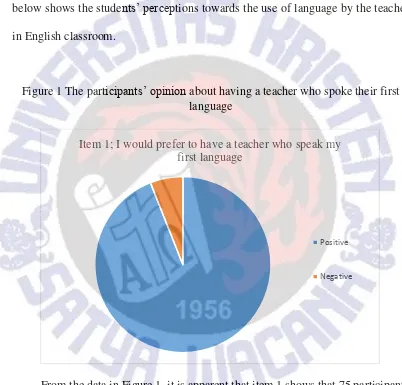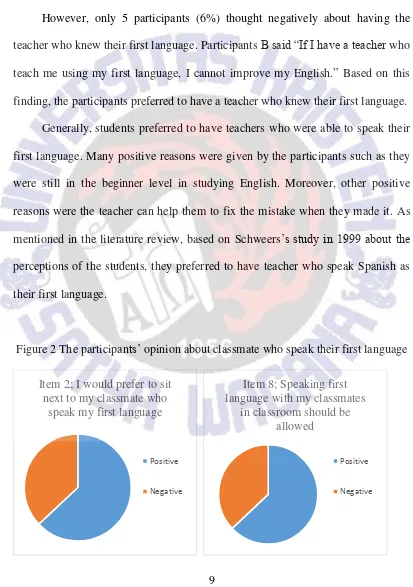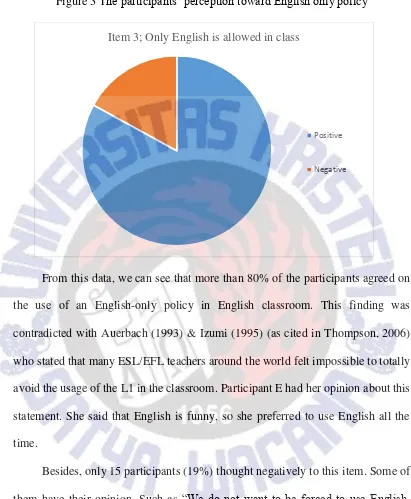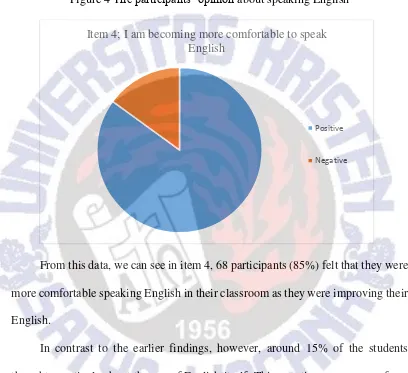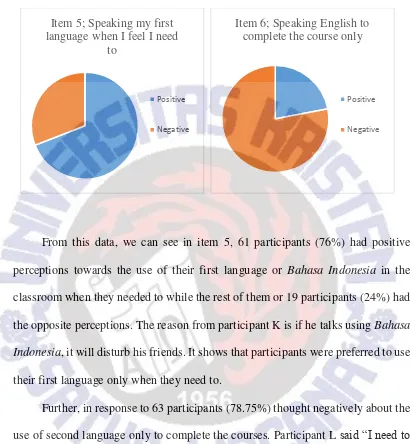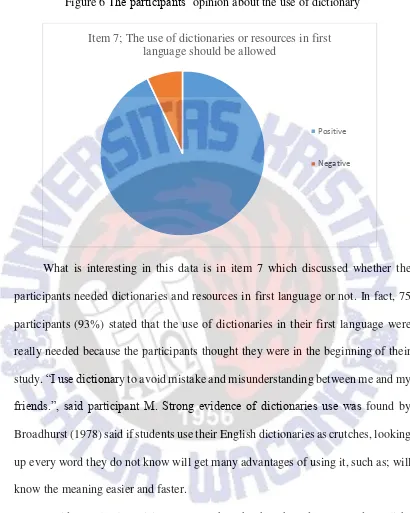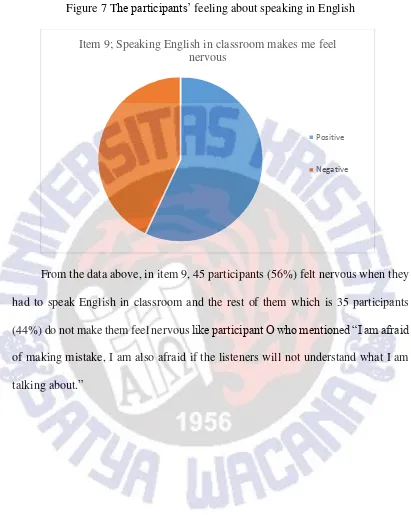FIRST YEAR
STUDENTS’ PERCEPTI
ONS TOWARD L2 USE
IN EFL CLASSROOMS
THESIS
Submitted in Partial Fulfillment of the Requirements for the Degree of
Sarjana Pendidikan
MAGDALENA KRISTIANI BUDIARTO 112012074
ENGLISH LANGUAGE EDUCATION PROGRAM
FACULTY OF LANGUAGE AND ARTS
UNIVERSITAS KRISTEN SATYA WACANA
ii
FIRST
YEAR STUDENTS’ PERCEPTIONS TOWARD L2 USE
IN EFL CLASSROOMS
THESIS
Submitted in Partial Fulfillment of the Requirements for the Degree of
Sarjana Pendidikan
MAGDALENA KRISTIANI BUDIARTO 112012074
ENGLISH LANGUAGE EDUCATION PROGRAM
FACULTY OF LANGUAGE AND ARTS
UNIVERSITAS KRISTEN SATYA WACANA
vii
COPYRIGHT STATEMENT
This thesis contains no such material as has been submitted for examination in any course or accepted for the fulfillment of any degree or diploma in any university. To the best of my knowledge and my belief, this contain no material previously published or written by any other person except where the reference is made in the text.
Copyright@2016 Magdalena Kristiani Budiarto and Victoria Usadya Palupi, M.A-ELT.
viii
TABLE OF CONTENT
INSIDE COVER ………..……….... ii
APPROVAL PAGE ………...……….. v
PUBLICATION AGREEMENT DECLARATION ……… vi
COPYRIGHT STATEMENT ... viiii
TABLE OF CONTENT ... viiiii
ABSTRACT ... 1
INTRODUCTION ... 2
LITERATURE REVIEW ... 4
Definition of perception ... 4
The Advantages and disadvantages of the use of L2 ... 5
THE STUDY ... 6
Context of the study ... 6
Participants ... 6
Data collection instruments ... 6
Data collection procedures ... 6
Data analysis procedures ... 7
FINDINGS AND DISCUSSION ... 8
ACKNOWLEDGEMENTS ... 18
REFERENCES ... 20
1
FIRST YEAR
STUDENTS’ PERCEPTI
ONS TOWARD L2 USE
IN EFL CLASSROOMS
Magdalena Kristiani Budiarto
ABSTRACT
The language use by the teachers and the students in classroom has pros and cons results whether they use first language (L1) or second language (L2). In this case, L1 refers to Bahasa Indonesia. Many teachers and students in Indonesia still use L1 in English teaching and learning process. That is why aimed of this study is to
answer the research question about students’ perceptions toward L2 use in EFL (English as a Foreign Language) classrooms. Further, this study was conducted using open-ended questionnaire. The participants of this research were first year students of English Language Education Program (ELEP) from Faculty of Language and Arts (FLA) in Universitas Kristen Satya Wacana, Salatiga (UKSW).
There were 9 questions and categorized them in students’ preferences, students’
2
INTRODUCTION
Recently, researchers have shown an increasing interest in educational
institutions which have their own “policy” of which language they want their
classes taught in; the students’ first language or the second language. In Faculty of
Language and Arts Universitas Kristen Satya Wacana (FLA-UKSW), most of the lessons were taught in English. However, a major problem with this kind of topic is students in this faculty have different background knowledge of English.
Sharaeai (2012) conducted a study which aimed to find students’ perceptions toward the language use in English classroom. He worked in total 51 participants from different majors at the large university, most were in the Engineering and English Department. He found that the students were preferred to use their first language.
Moreover, in his paper, he found that Schweers (1999) carried out a study to investigate the reasons and amount of L1 or first language usage in the English classrooms. He investigated the use of Spanish in English classes in the University of Puerto Rico. His study found out that about 88.7 percent of the students thought Spanish should be used. And none of the students thought the teachers should stop using Spanish in the classroom. This shows differences between how the two perceive L1 usage in the classroom. Most of the teachers and students agreed that Spanish should be used to explain difficult concepts.
3
second language ability. The students agreed that they preferred to have the teacher who are able to talk in their L1 to explain the grammar point.
Cook (2001) argued that although the teachers try their best to separate the first language from second language in their teaching by trying to use a number of techniques. As a result, even if the teacher tried to separate the two languages, the students would still refer to them and connect them in their minds.
Levine (2003) conducted a study based on an online questionnaire about the attitudes of university students and instructors regarding the use of the first and the target language. His participants were first and second year students of French, German, and Spanish. All the participants were either native speakers of English or bilingual speakers. The study found out that teachers and students usually used the first language to discuss class assignments, course policies, and for class management.
This study examined the perceptions from the first year students at English Language Education Program, Universitas Kristen Satya Wacana (ELEP-UKSW) toward L2 (second language) use. This study was expected to provide information about their preferences in using language in a classroom, in this case, Bahasa Indonesia as L1 (first language) and English as L2. This study helps to understand
students’ perceptions about the language use at ELEP-SWCU.
4
ability in learning English; in speaking English or even only to pronounce English words.
LITERATURE REVIEW
The use of the first language in English classroom has been and will remain an issue that everyone has an opinion about. Some of teachers and students are against the use of first language and they have their own reason. In this chapter of the paper, we will see some of the studies that have been conducted to investigate the use of second language in EFL classroom.
This literature review will be organized into two parts. First, we will see a brief definition of perception. Second, some advantages and disadvantages of the use of second language in EFL classrooms will be reviewed.
Definition of perception
First, a brief definition about perception will be given. According to Hong (2003) (as cited in Permatasari, 2014) perception is someone thought about something that they learn to measure how their attitude toward using something, whether they agree or not about that method or about something that they learn. Moreover, Sidhu (2003) (as cited in Permatasari, 2014) stated that students’
perceptions are students’ point of view toward something that happened in learning
process. From the definition above, we can conclude if students’ perception means
how students’ thought to response about they have done or about what they have
5
The Advantages and disadvantages of the use of L2
Using the second language in learning can make the students more aware to the use of the target language. In the foreign language classroom, the exclusive use of second language is necessary to use in order to provide a context for learners to communicate using the second language in a more meaningful and authentic manner.
Chaudron (1988) (as Cited in Rabbidge & Chappell, 2014) argued that the best competence in the foreign language is realized by creating a rich second language environment that uses English for not only instruction but also disciplinary and management”. Moreover, Singleton (1989) argued that “L2 learners are different from children acquiring their L1 because they have more mature minds, greater social development and larger short-term memory capacity.
Moreover, Prodromou (2003) (as cited in Hanna & Majeda, 2012) stated that
“L1 is useful in L2 classroom situations as in giving instructions, and sorting out
activities. He said if the students’ L1 is very useful for students in learning the target
6
THE STUDY
Context of the studyThis study was conducted at ELEP-UKSW. This study attempted to explore
the students’ perceptions toward L2 use in EFL classroom. This study was
conducted in ELEP-UKSW because the students in Faculty of Language and Arts have to learn and use English in every course.
Participants
There were 80 participants of first year students of the FLA-UKSW, majoring in ELEP. Common to all the participant was having their first year of study in FLA, and at least they had 10 years of studying English. The reason why they were chosen to be the participants is because accessibility and flexibility to meet them. The age of the students mostly ranged from 18 to 20. The participants came from both gender; male and female.
Data collection instruments
For this study, the questionnaire was used to explore students’ perception toward language use in a classroom. It used was adapted from Sharaeai (2012). It consists of 9 questions with 4 options for each number; strongly agree, agree, disagree and strongly disagree (see Appendix 1). Moreover, the questionnaire were asked not only about students’ preferences of their teachers’ and classmate language use, but also it asked about their perceptions about speaking activity, English as a policy and dictionaries used in a classroom. Further, the questionnaire was edited to be open-ended question which participants should give the reason for each number.
Data collection procedures
7
students). The participants were asked to fill the questionnaire based on the instruction in the questionnaire. Then, it took around 4 days in a total time to get the complete data from the participants.
Data analysis procedures
8
FINDINGS AND DISCUSSION
This part presents overall of the study’s result. This result and discussion
differed according to the participants’ own personal opinions. The finding was
divided into two parts, they were positive and negative perceptions. Diagram 1 below shows the students’ perceptions towards the use of language by the teacher in English classroom.
Figure 1 The participants’ opinion about having a teacher who spoke their first language
From the data in Figure 1, it is apparent that item 1 shows that 75 participants (94%) thought positively about having a teacher who understood their first language. For example, participant A said “Teacher who understand our first language can help us to understand the material easily. They can make us easier to catch it.” This finding was in line with the study by Cook (2001) that found the different ways in which first language (L1) could be positively used in the foreign
Item 1; I would prefer to have a teacher who speak my first language
Positive
9
language classroom. He argued that L1 and L2 have two different linguistic systems. For that reason, teacher usually encourage students to avoid using L1 or comparing the two languages.
However, only 5 participants (6%) thought negatively about having the teacher who knew their first language. Participants B said “If I have a teacher who teach me using my first language, I cannot improve my English.” Based on this finding, the participants preferred to have a teacher who knew their first language.
Generally, students preferred to have teachers who were able to speak their first language. Many positive reasons were given by the participants such as they were still in the beginner level in studying English. Moreover, other positive reasons were the teacher can help them to fix the mistake when they made it. As mentioned in the literature review, based on Schweers’s study in 1999 about the perceptions of the students, they preferred to have teacher who speak Spanish as their first language.
Figure 2 The participants’ opinion about classmate who speak their first language
Item 2; I would prefer to sit next to my classmate who
10
From this data, we can see that more than 50% of the students still preferred to have classmates who spoke in the first language. Regarding students’ preferences about using first language with classmates, participant C mentioned “We can motivate each other because we can talk about anything with our first language, include talk about the lesson.”
The results showed that the participants preferred to sit next to their classmates who can speak their first language. The participants said they usually use their first language to chat with their classmate about general and personal topics that are not connected to the textbook. This finding is in line with Manara (2007) that found the students should use English with the teachers in the classroom all the time.
However, the rest of them which were around 30% of the students gave negative responses. They stated that having classmates who spoke first language would not improve their English ability. Participant D had his own opinion, he said
“If she (his classmate who speaks their first language) sits next to me, I cannot
11
Figure 3 The participants’ perception toward English only policy
From this data, we can see that more than 80% of the participants agreed on the use of an English-only policy in English classroom. This finding was contradicted with Auerbach (1993) & Izumi (1995) (as cited in Thompson, 2006) who stated that many ESL/EFL teachers around the world felt impossible to totally avoid the usage of the L1 in the classroom. Participant E had her opinion about this statement. She said that English is funny, so she preferred to use English all the time.
Besides, only 15 participants (19%) thought negatively to this item. Some of them have their opinion. Such as “We do not want to be forced to use English, because we are still learning.” (Participant F & Participant G). Further, the negative reason also came from participant H who said “Using English all the time in the
classroom may cause misunderstanding.” In general, there are similarities between
the reason expressed by the students in this study and those described by Auerbach
Item 3; Only English is allowed in class
Positive
12
(1993) who argued that the bilingual policy is not only effective but also necessary for adult ESL.
Figure 4 The participants’ opinion about speaking English
From this data, we can see in item 4, 68 participants (85%) felt that they were more comfortable speaking English in their classroom as they were improving their English.
In contrast to the earlier findings, however, around 15% of the students thought negatively about the use of English itself. This negative reason came from participant I and participant J who said “We also have to develop our speaking skill outside the classroom.” Manara (2007) also gave her opinion, she stated that students were probably wish to have more exposure by listening to the teachers who spoke English.
Item 4; I am becoming more comfortable to speak English
Positive
13
Figure 5 The participants’ opinion about speaking first language
From this data, we can see in item 5, 61 participants (76%) had positive perceptions towards the use of their first language or Bahasa Indonesia in the classroom when they needed to while the rest of them or 19 participants (24%) had the opposite perceptions. The reason from participant K is if he talks using Bahasa Indonesia, it will disturb his friends. It shows that participants were preferred to use their first language only when they need to.
Further, in response to 63 participants (78.75%) thought negatively about the use of second language only to complete the courses. Participant L said “I need to be able to speak English to prepare for my future.” In general, the participants felt that they needed to use English in classroom not only for completing the course, but also to improve their ability in speaking the second language. This finding is contradictory to the response to item 3 which stated that more than 50% students agreed about English only policy in the classroom.
Item 5; Speaking my first language when I feel I need
to
Positive
Negative
Item 6; Speaking English to complete the course only
Positive
14
Figure 6 The participants’ opinion about the use of dictionary
What is interesting in this data is in item 7 which discussed whether the participants needed dictionaries and resources in first language or not. In fact, 75 participants (93%) stated that the use of dictionaries in their first language were really needed because the participants thought they were in the beginning of their study. “I use dictionary to avoid mistake and misunderstanding between me and my
friends.”, said participant M. Strong evidence of dictionaries use was found by
Broadhurst (1978) said if students use their English dictionaries as crutches, looking up every word they do not know will get many advantages of using it, such as; will know the meaning easier and faster.
Besides, only 5 participants (7%) thought that they do not need English-Indonesian dictionaries. The reason from participant N was if they need to try use English without dictionaries.
Item 7; The use of dictionaries or resources in first language should be allowed
Positive
15
Figure 7 The participants’ feeling about speaking in English
From the data above, in item 9, 45 participants (56%) felt nervous when they had to speak English in classroom and the rest of them which is 35 participants (44%) do not make them feel nervous like participant O who mentioned “I am afraid of making mistake, I am also afraid if the listeners will not understand what I am talking about.”
Item 9; Speaking English in classroom makes me feel nervous
Positive
16
CONCLUSION
This research has investigated the students’ perceptions toward L2 use in
classroom. In general, there were various reason for using first language and second language in the classroom. We can conclude that; First, participants in open-ended questionnaire agreed that they sometimes used the first language to explain and ask about the new ideas and concepts presented in English class. Participants in previous study (Sharaeai, 2012) also said they sometimes use their first language, and they would prefer having their first language used a little in the English classrooms. Second, most of the students agreed to have the teachers and classmates who spoke their first language. Third, most of the participants agreed with the English only policy in their classroom. Fourth, as their language improved, they also feel more comfortable using English in English classroom. However, that contradicted to the finding which showed that students felt nervous when they needed to speak English in the classroom.
17
Finally, the suggestion comes to the teachers as well as the students who learned English as their foreign language. Hopefully, this suggestion can help them improve their English learning and teaching. First, this suggestion is for teachers such as they can change their styles in teaching by using direct method to force the students use English in learning; speak English during the class also they can reduce the amount of first language use. Next, the suggestion for the students in this faculty is they need to change their mind set to use English in every situation; not only when they ask for the explanation from their teachers but also when they talk with their classmates. Considering they will be a future English teacher, they need to accustom themselves with English.
18
ACKNOWLEDGEMENTS
I would like to thank;
1. My Savior Jesus Christ who gives me strength and never leave me alone until I can finish writing this thesis.
2. My super mama Melanie Wulandari who always reminded and asked about the progress of this thesis before she leaves. I believe you can watch my effort from above and I promise I will make you proud. “Yes, akhirnya skripsiku selesai ma, aku S1 lho. I miss you a lot, ma..”
3. My supervisor Victoria Usadya Palupi, M.A-ELT who supervised me well. 4. My thesis examiner Yustinus Calvin Gai Mali, M.Hum. who gave the best
solution when I face many difficulties during the writing process.
5. My papa, Richard Budiarto who gave me support (moral dan material). My grand-mom, Corry Indrawati who always waits for me to come home. My beloved sissy and my mentor, Priskila Kristanti Budiarto. My older brothers, Yonatan Oktavianus Budiarto and Andreas Kristian Budiarto. My sissy in law, Elizabeth Hanna Eka Christy. My beloved niece, Joanne Dominique Budiarto, thank you for always make me smile. I love you all.
6. My lovely friends, Theodora Adeline and Margareta Cartona, Makasih yaaa.
Someday, aku pasti bakal sampe ke rumah kalian di Pangkalan Bun sana.
7. My Ibu dan Bapak Kost, Mbak Yuni and Mas Yoki and your cute son Abe, I will miss your advice.
19
my thesis. “Akhirnya aku nulis namamu di sini oh.. Makasih ya.. I love you lho
20
REFERENCES
Al Sharaeai, W. A. A. (2012). Students’ perspectives on the use of L1 in English
classrooms. Unpublished doctoral dissertation, Iowa State University, Iowa. Alenezi, A., A. (2010). Students’ language attitude towards using code-switching
as a medium of instruction in the College of Health Sciences: An exploratory study. ARECLS, 7, 1-22.
Channa, M. A. (2012). Teachers’ perceptions towards English Language as medium of Instruction in Pakistan. Interdisciplinary Journal of Contemporary Research in Business, 4 (5), 759-764.
Dickson, P. (1996). Using the target language a view from the Classroom. National Foundation for Educational Research.
Hanna, N. H., & Majeda, A. (2012). The use of the first language in second language learning reconsidered. College Student Journal. 46 (1), 1-13. Hartono, D. A. W. (2013). Teachers’ perception about the use of English and
Indonesian in the EFL Classroom. Unpublised bachelor’s thesis, Satya Wacana Christian University, Salatiga, Central Java, Indonesia.
Manara, C. (2007). The use of L1 support: Teachers’ and students’ opinions and practices in Indonesian context. The Journal of Asia TEFL, 4 (1),145-178. Mohebbi, H., & Alavi, S., M. (2014). An investigation into teachers’ first language
use in a second language learning classroom context: A Questionnaire-based study. Bellaterra Journal of Teaching & Learning Language & Literature, 7
(4), 57-73.
Nilsson, M. (2013). Target language in the primary classroom. Unpublished doctoral dissertation, Stockholms Universitet.
Permatasari, R., R. (2014). Students’ perceptions toward teachers’ use of Bahasa Indonesia in English learning classroom. Unpublished bachelor’s thesis, Satya Wacana Christian University, Salatiga, Central Java, Indonesia. Rabbidge, M., & Chappell, P. (2014). Exploring Non-native English speaker
teachers’ classroom language use in South Korean elementary schools. The Electronic Journal for English as a Second Language,17 (4), 1-7.
Thompson, G. L. (2006). Teacher and student first language and target language use in the foreign language classroom: A qualitative and quantitative study of language choice. Unpublished doctoral dissertation, The University of Arizona.
21
Walkinshaw, I., & Duong, O. T. H. (2012). Native-and Non-Native Speaking English teacher weighing the benefits. The Electronic Journal for English as a Second Language, 16 (3), 1-17.
22
APPENDIX
Dear Friends,
In order to continue my thesis, I need your help to fill in this questionnaire honestly.
This questionnaire is to answer the research question: ‘What are the students’
perceptions toward the use of L2 in ESL classroom?’ Your response to the questionnaire will not affect your grade and will be kept confidential. Feel free to fill it in Bahasa Indonesia. Many thanks.
A.Demographic information NIM :………..
Gender: Male/Female (circle accordingly)
B.Put a check mark () in the appropriate option.
1. In English class, it is best to have a teacher who can understand my first language.
Strongly agree Reason :
Agree _________________________________
Disagree _________________________________
Strongly disagree _________________________________ 2. I would prefer to sit next to a classmate who speaks my first language in
English class.
Strongly agree Reason :
Agree ___________________________________
Disagree ___________________________________
Strongly disagree ___________________________________ 3. I think my English class should have an “English OnlyPolicy.” (This
means only English is allowed in the English classroom.)
Strongly agree Reason :
Agree __________________________________
23
Strongly disagree __________________________________ 4. As my English improves, I am becoming more comfortable speaking only
English in English class.
Strongly agree Reason :
Agree _________________________________
Disagree _________________________________
Strongly disagree _________________________________ 5. I want to be able to speak my first language in English class when I feel I
need to.
Strongly agree Reason :
Agree _________________________________
Disagree _________________________________
Strongly disagree _________________________________ 6. It’s not important to speak only English in class as long as I am
completing the course tasks.
Strongly agree Reason :
Agree _________________________________
Disagree _________________________________
Strongly disagree _________________________________ 7. Using dictionaries and resources in the first language should be allowed in
English class.
Strongly agree` Reaason :
Agree __________________________________
Disagree __________________________________
Strongly disagree __________________________________ 8. Speaking my first language with my classmates between and during class
activities should be okay as long as the course is not a speaking class.
Strongly agree Reason :
Agree __________________________________
Disagree __________________________________
24
9. Having to speak English only in class makes me feel nervous.
Strongly agree Reason :
Agree ___________________________________
Disagree ___________________________________
Strongly disagree ___________________________________
C. Consent form
If I need more information on your questionnaire, can I contact you for an interview? Yes/No (circle one)
If you say Yes, complete the following information:
Name: ……….. Email:………
HP: ………
